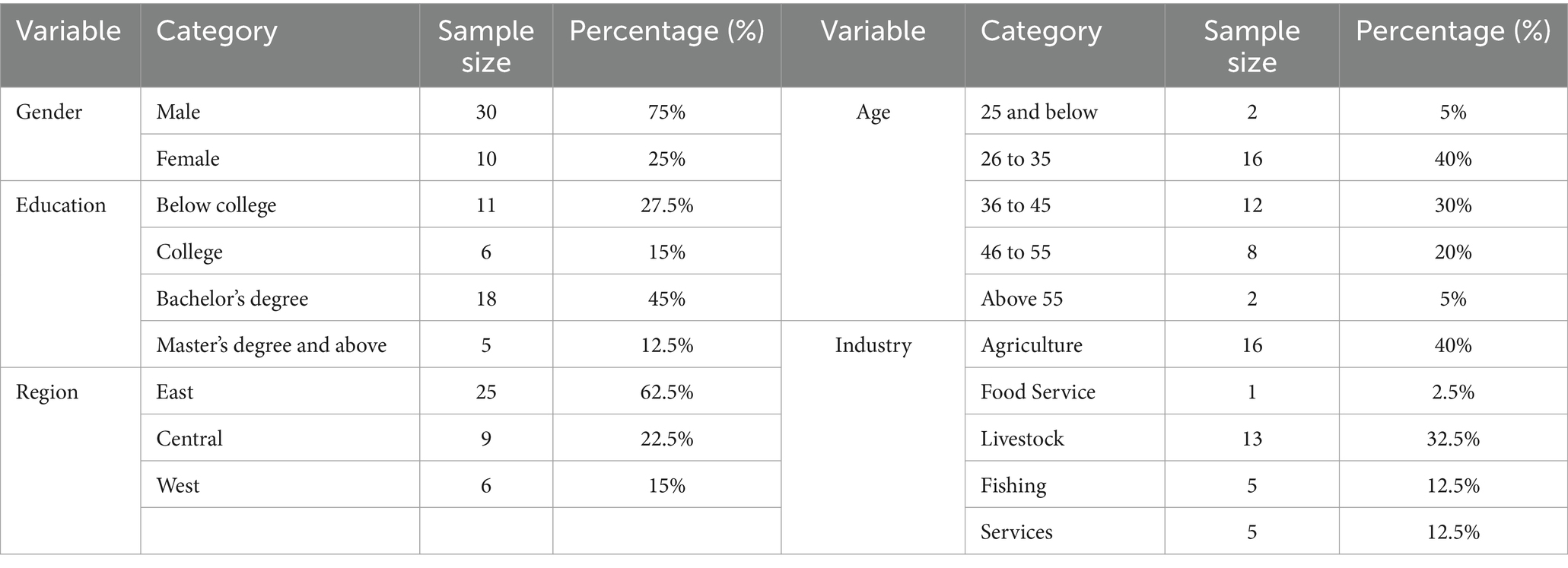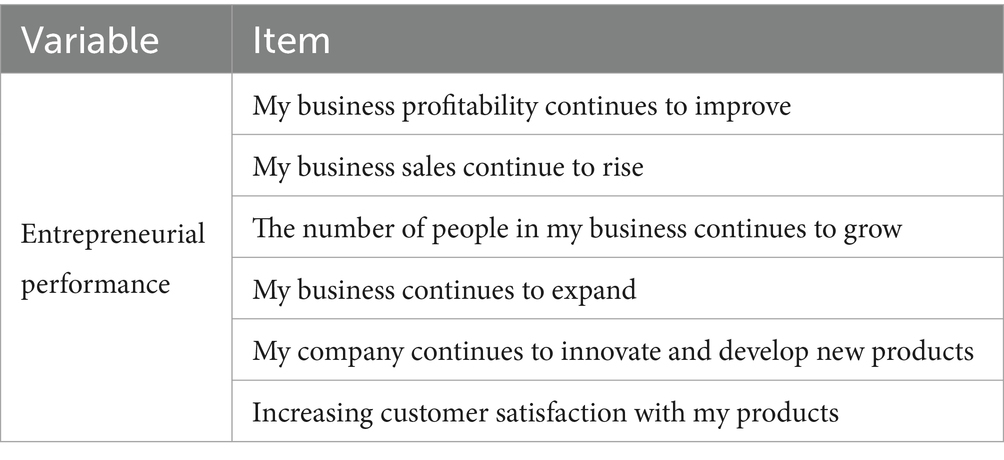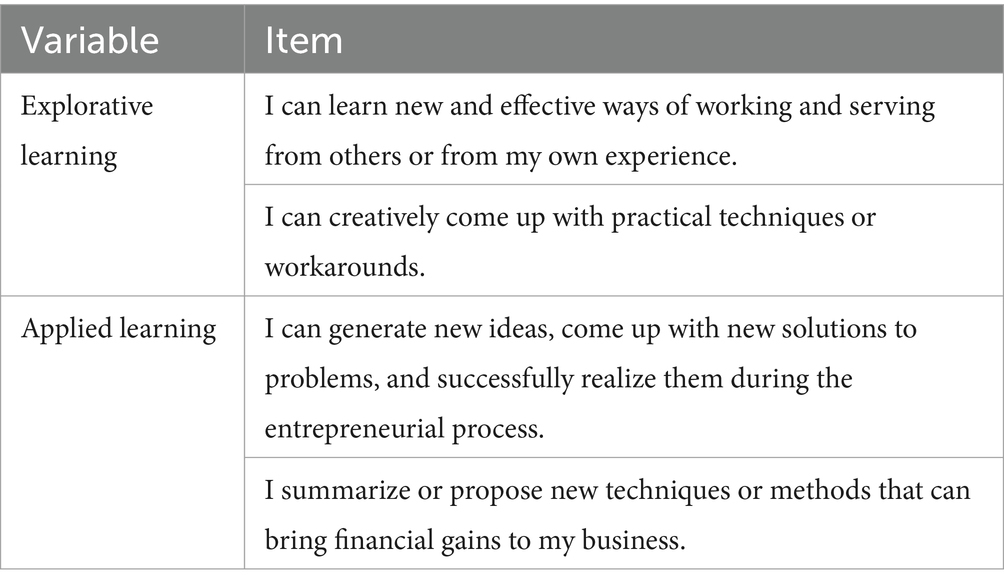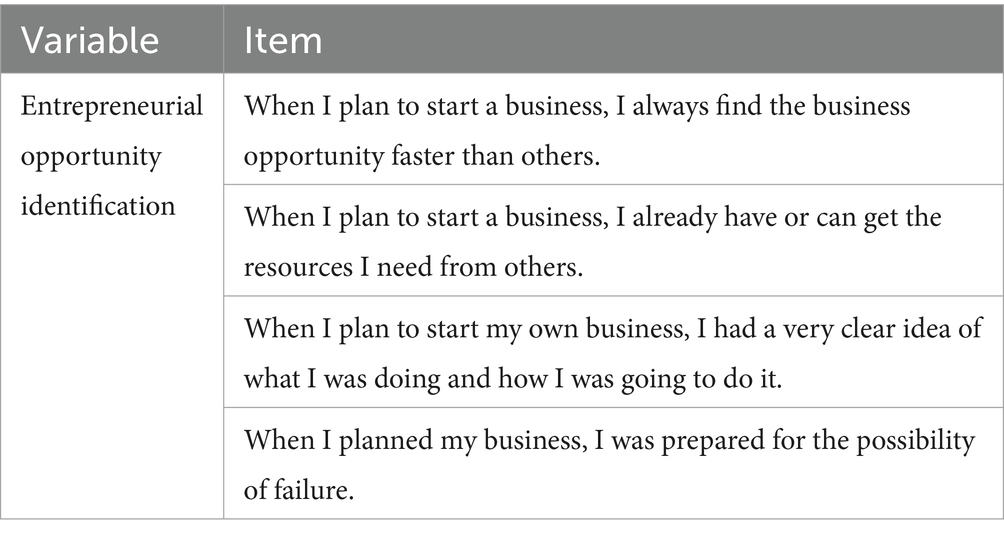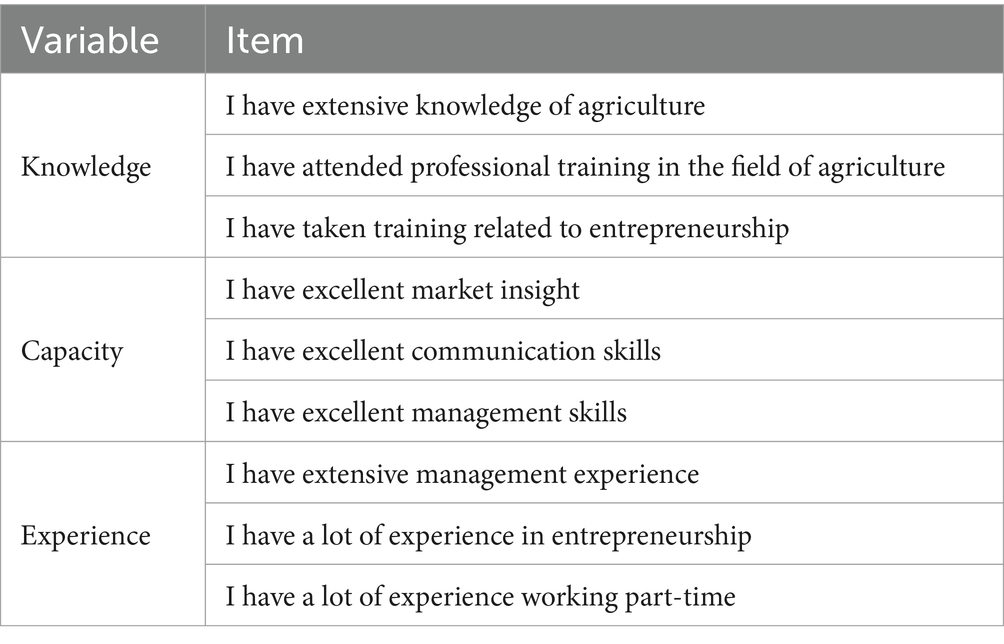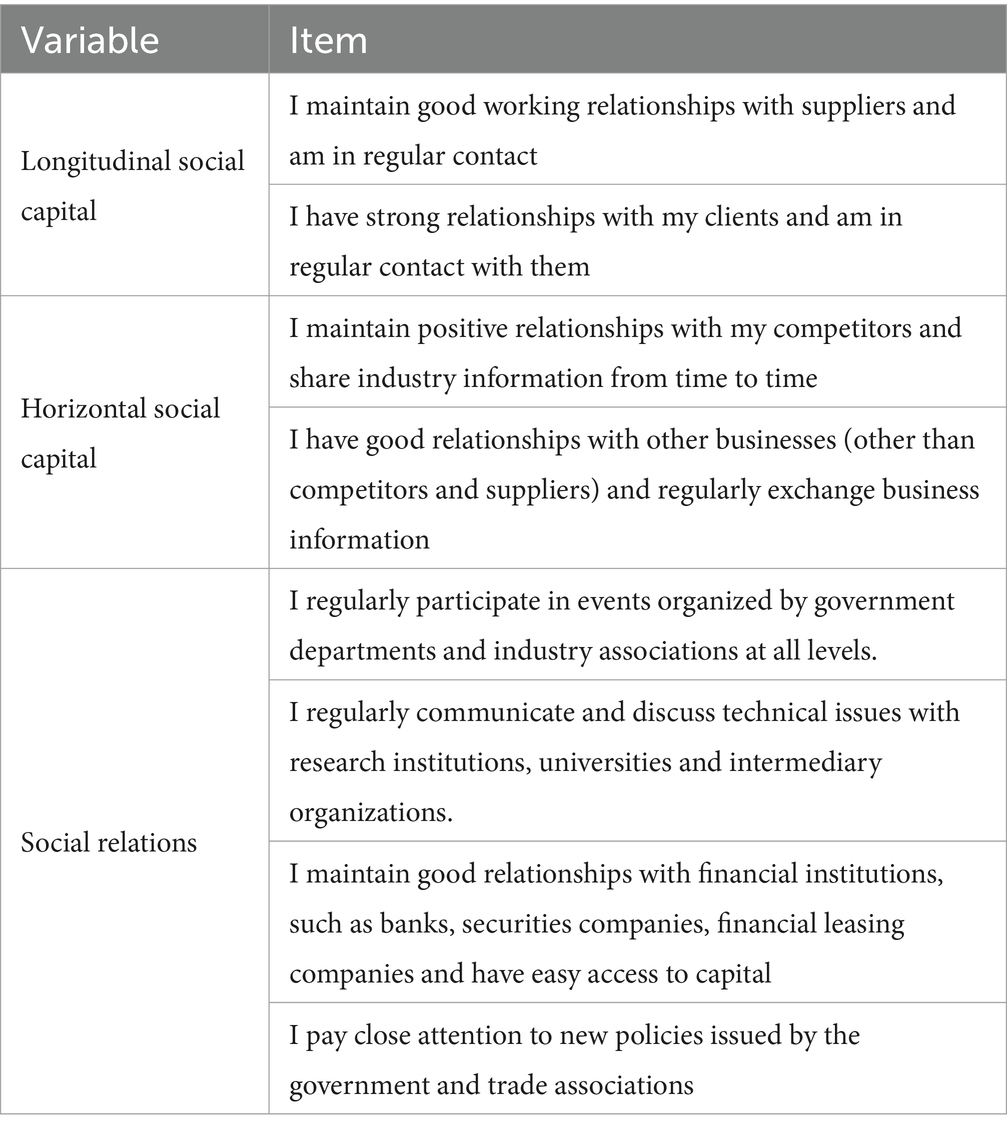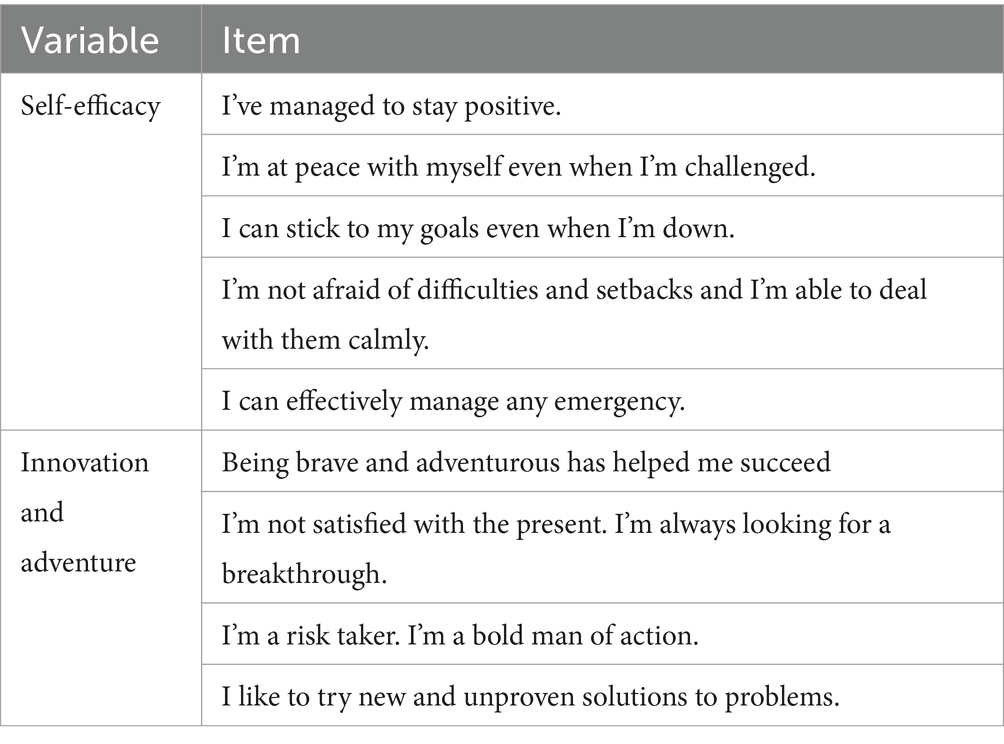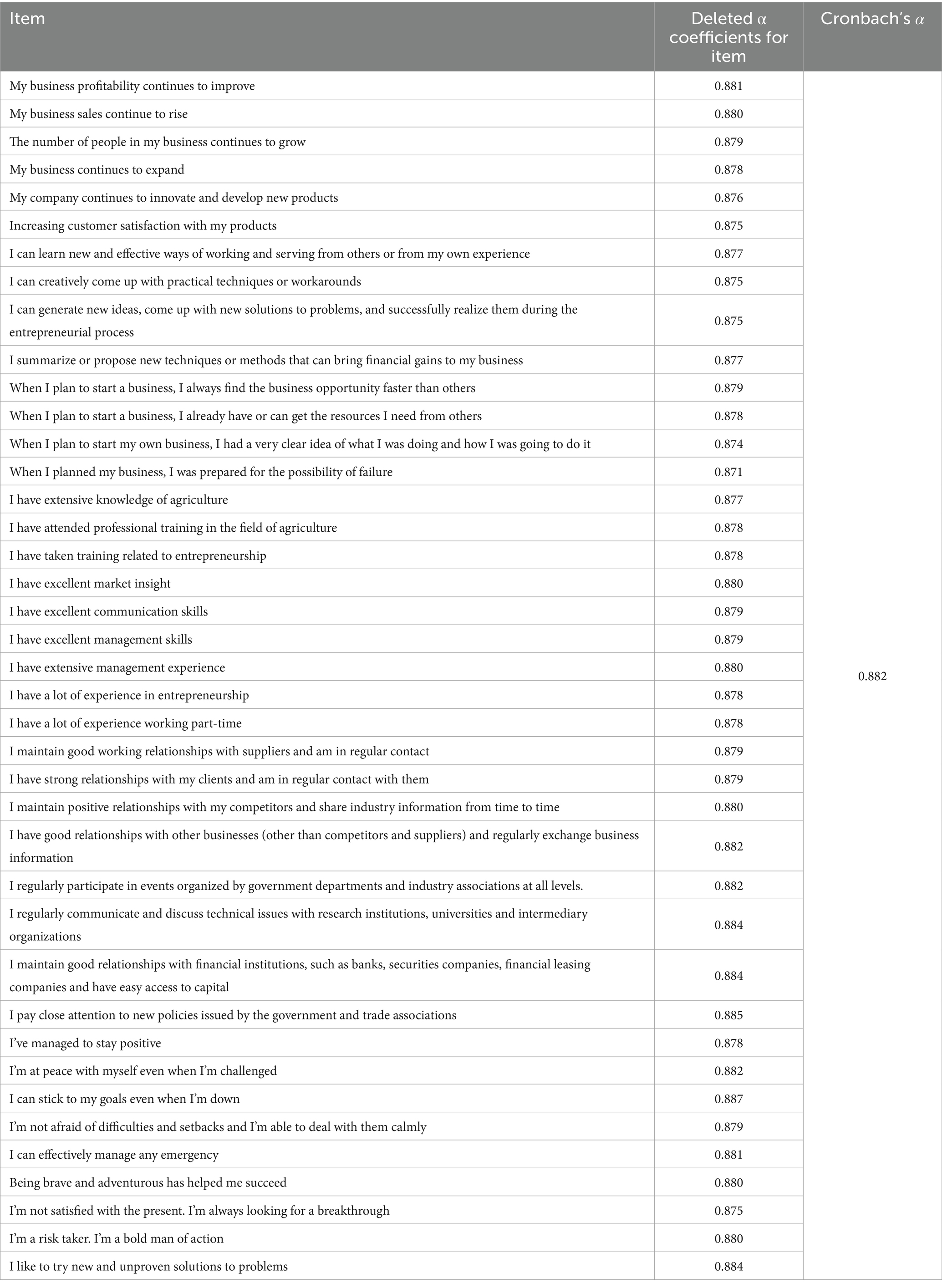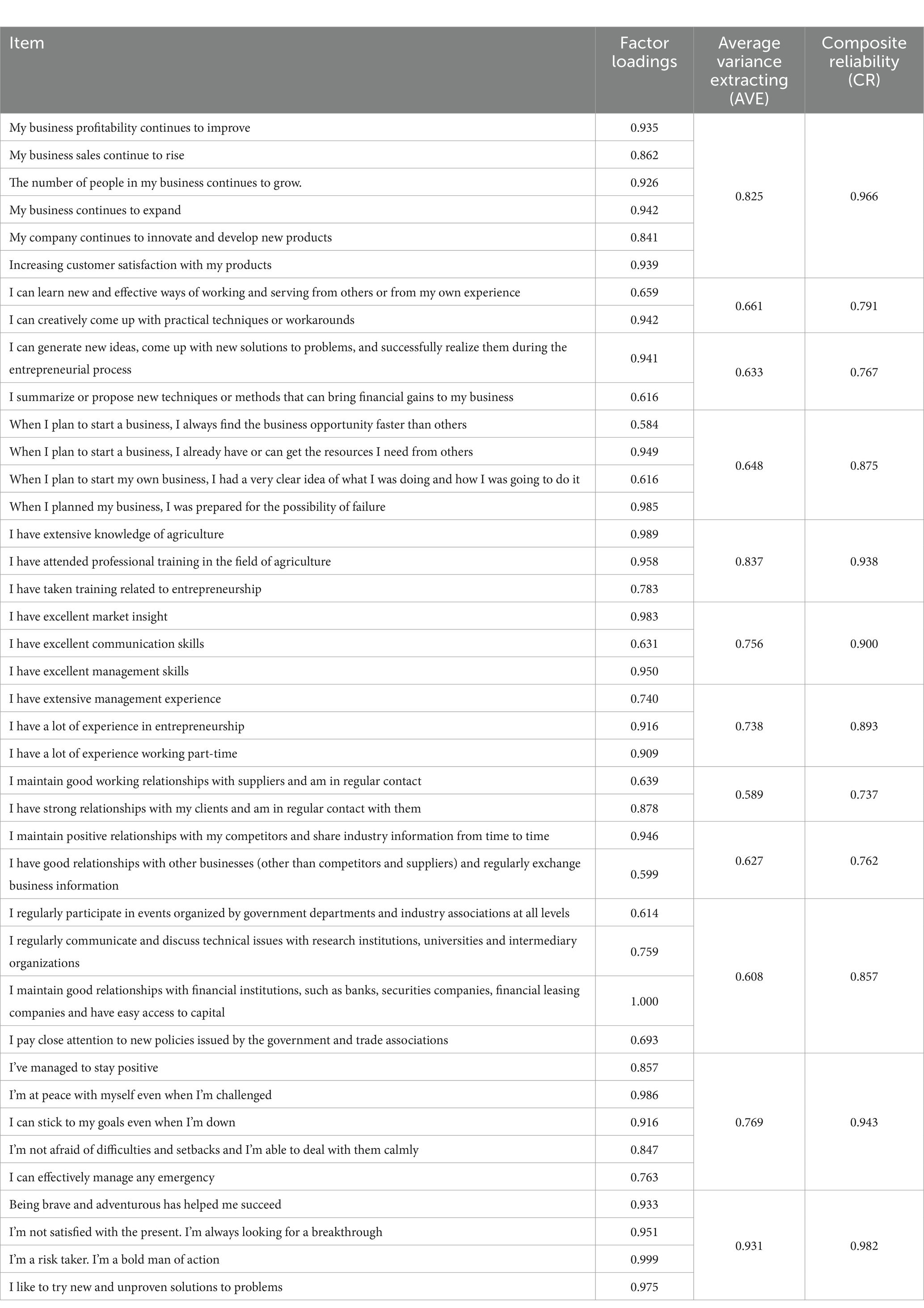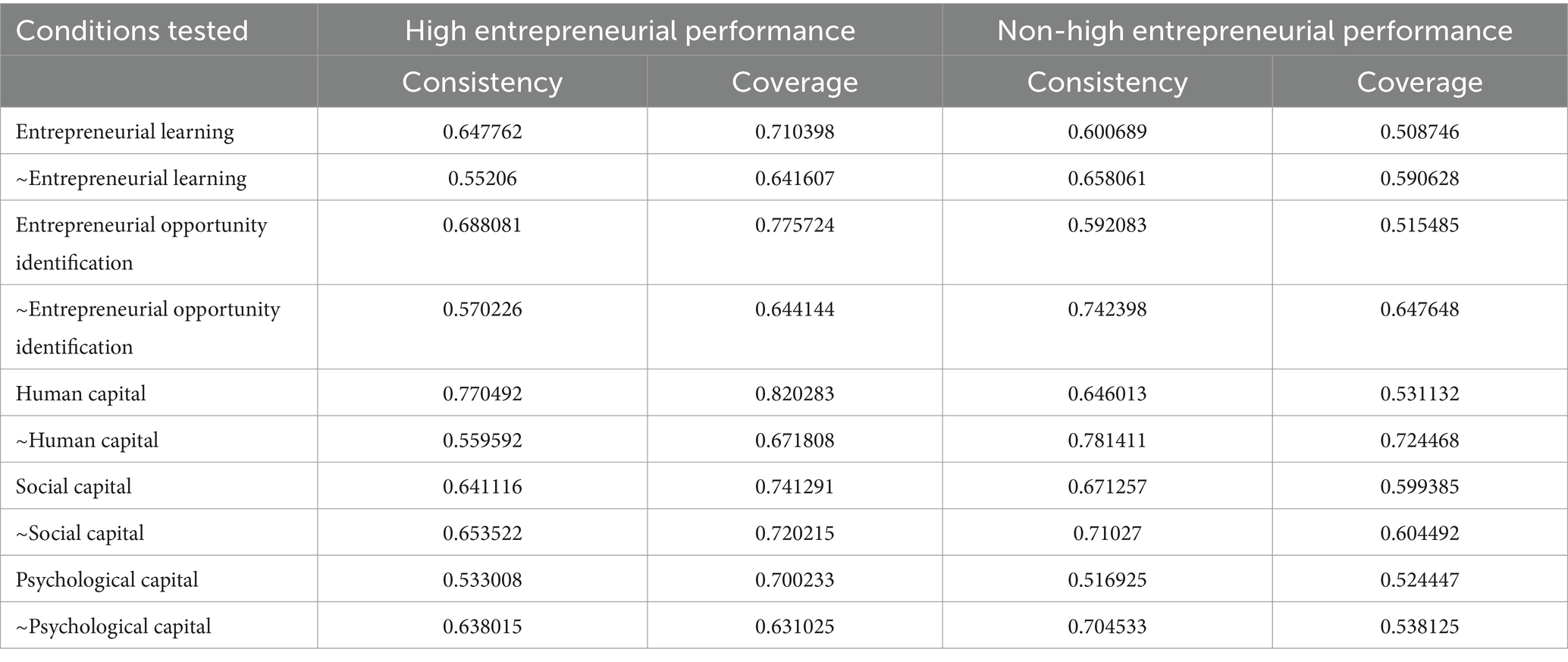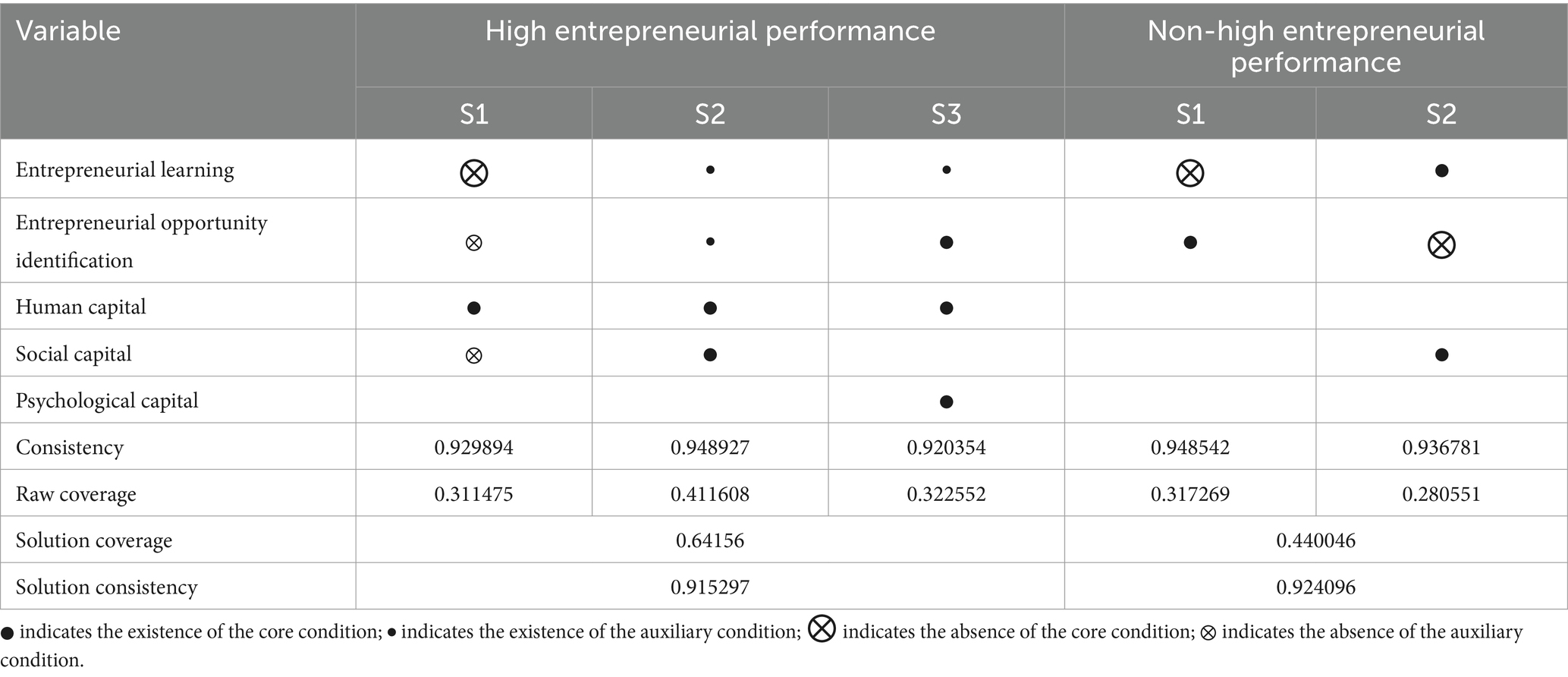- 1School of Economics and Management, Chongqing Normal University, Chongqing, China
- 2Institute of Quantitative Economics, Huaqiao University, Xiamen, China
Based on the configuration theory, this paper discusses the multiple concurrent causes and causal complex mechanisms affecting the performance differences among different new farmers. Using the fuzzy set qualitative comparative analysis method, taking 40 cases of CCTV’s “ZHI FU JING” column as samples, the paper analyzes the necessary conditions for new farmers to produce high performance by the anthefactory-variable configuration composed of human capital, social capital, psychological capital, entrepreneurial learning and entrepreneurial opportunity identification. The results show that: (1) high human capital is the necessary core condition for new farmers to produce high entrepreneurial performance, lack of high entrepreneurial learning and lack of high entrepreneurial opportunity identification is the core necessary condition for low entrepreneurial performance; (2) the driving mechanism of new farmers’ high entrepreneurial performance is divided into three paths, and the driving mechanism of new farmers’ low entrepreneurial performance is divided into two paths; and (3) the ways of inhibiting new farmers’ performance and promoting their performance are asymmetrical.
1 Introduction
Rural development is a pivotal component in the attainment of the Sustainable Development Goals (SDGs) for 2030, with Sustainable Development Goal 2 (SDG 2) explicitly emphasizing the significance of bolstering and reinforcing family farming. Family farming plays a key role within the globe, contributing to rural employment and economic growth (Saridakis et al., 2021). In light of globalization, rural development is not only an international issue, but also a focus of attention for China as an agricultural powerhouse. In the new stage of development, the issue of “agriculture, rural areas and farmers” is the top priority of the whole Party’s work, and the rural revitalization is the general grasp of “agriculture, rural areas and farmers” work. The No. 1 Central Document of 2023 proposed to accelerate the high-quality development of rural industries, support and encourage rural employment and entrepreneurship, and expand employment channels. Against this background, China has continuously increased its policy tilt and continued to guide the flow of development factors such as capital, talent and technology to rural areas, and the entrepreneurial environment in the countryside has been increasingly improved (Lan et al., 2018).
Entrepreneurship is a key driver of economic development (Zhu et al., 2022). According to statistics, China’s rural online retail sales reached 2.05 trillion yuan, and 11.2 million people of all kinds returned to their hometowns to start businesses. More than 80% of the entrepreneurial projects are the integration projects of the primary, secondary and tertiary industries, which led to the booming development of a large number of productive and living services such as express logistics, live streaming with goods, and leisure agriculture [E-commerce in China (2021) by Ministry of Commerce of the People’s Republic of China]. It can be seen that the entrepreneurial activities of returned entrepreneurs directly affect the local economic growth and the increase of job opportunities, thus promoting the prosperity and development of the countryside (Démurger and Xu, 2011).
A group of young people who are full of affection for agriculture, rich in ideals and bold in innovation have embarked on the road of rural revitalization. As an emerging social group of rural innovation and entrepreneurship, new farmers have promoted the transformation of traditional agriculture to modern agriculture, positively changed the pattern of the “three rural areas,” promoted the integrated development of primary, secondary and tertiary industries, and optimized and adjusted the economic structure (Li and Fan, 2023). New farmers are leaders in the revitalization of industries, and are adept at applying new concepts, new thinking and new technologies to engage in distinctive production and management activities and increase the added value of their products, thus enriching and expanding the rural economy and injecting new vitality into the transformation of traditional agriculture (Research Group of Rural Economic System and Management Department Ministry of Agriculture and Zhang, 2016; Liu M. et al., 2024). The role of New Farmers in China’s rural revitalization aligns with the SDG 2 commitment to promote and support family farming. New farmers are capable of promptly acquiring information, are market-oriented, and adept at learning new things, utilizing new technologies to drive innovative ventures (Xie, 2021). The entrepreneurial actions of new farmers not only provide fresh perspectives for China’s rural revitalization, but also offer beneficial practices for achieving sustainable development goals, particularly in eradicating hunger and promoting sustainable agriculture.
With the growing group of new farmers, the theme of new farmers has been increasingly emphasized by academics. The existing research on new farmers mainly focuses on the concept, characteristics, classification, role and other aspects of new farmers have been initially explored (Wu et al., 2021). Some scholars have also explored how new farmers utilize livestreaming platforms to generate new economic reality based on an e-commerce perspective with a case study approach (Duan et al., 2023). Through the literature combing, it is found that the research method of new farmers is still in the stage of case study and qualitative analysis, and lacks the participation of quantitative analysis.
In the agricultural entrepreneurship context, the three-dimensional capitals of social, human and psychological constitute the entrepreneurial capital of the entrepreneurs, and scholars have studied how the individual capitals in the three-dimensional capitals affect the performance of farmers’ entrepreneurship from several aspects. Studies have shown that social capital, as the main way of obtaining external information and resources, can effectively improve the availability of entrepreneurial resources and is an important factor affecting the performance of farmers’ entrepreneurship (Xie et al., 2021; Yin and Zhou, 2023). Enhancing farmers’ human capital is an important way to improve farmers’ entrepreneurial performance and enhance the competitiveness of enterprises, and farmers need to have innovation ability, enterprise management ability and so on (Wang et al., 2020). Psychological capital is the key to facilitate farmers’ transformation of entrepreneurial potential into actual productivity, and it is an important psychological factor to promote personal development and performance improvement (Wang et al., 2022).
Entrepreneurial opportunity theory recognizes entrepreneurial opportunity as a key factor (Ardichvili et al., 2003). In the early stage of farmers’ entrepreneurship, it is crucial to explore, identify and develop entrepreneurial opportunities. Only when farmers find opportunities can they avoid the uncertainty of factor market, so as to assign value, improve and innovate new products. Therefore, new farmers’ entrepreneurship cannot be separated from the process of entrepreneurial opportunity identification (An et al., 2018; Ma and Yang, 2021). Based on organizational learning theory, entrepreneurial learning refers to the process of acquisition, sharing and use of knowledge by entrepreneurs, thus promoting the acquisition of innovative knowledge by enterprises (Toft-Kehler et al., 2014; Wang and Chugh, 2014). The existing studies tend to use quantitative methods such as regression analysis to explain the average net effect between the independent variable x and the dependent variable y (Miao et al., 2021; Shen, 2024; Shen and Zhang, 2024), focusing only on single causality or intrinsic mechanism problems, and failing to satisfy the complex causality and antecedent variable asymmetry that exists in actual entrepreneurial practice.
To address these research gaps, this study takes 40 cases of new farmers ‘entrepreneurship, takes histomorphic theory as the core, and applies the fuzzy set qualitative comparative analysis (fsQCA) method to explore the effects of the interaction between the capital level (social, human, and psychological) and the organizational level (entrepreneurial learning, and entrepreneurial opportunity identification) on the entrepreneurial performance of new farmers, and to reveal the paths of differentiation of the entrepreneurial performance of new farmers. From the theoretical level, although the existing studies have found the fact that farmers’ entrepreneurial performance is affected by a variety of factors, they have not explored the group effect of the joint action of multiple factors. This study expands the research ideas and research direction of new farmers’ entrepreneurial performance. From the practical level, the realization and maintenance of high performance of new farmers should be combined with the characteristics of their own resources, and appropriate resource combination strategies should be adopted according to the actual situation.
This paper faces two main challenges in quantifying the indicators of new farmers. First, a comprehensive indicator system for assessing new farmers may be subject to expert subjectivity, leading to biased estimates. Second, uncertainty in the distribution of new farmers may affect sampling, leading to biased estimates. To address these challenges, this paper summarizes relevant literature and expert recommendations to construct a more comprehensive indicator system on entrepreneurial performance, social capital, human capital, psychological capital, entrepreneurial learning, and entrepreneurial opportunity identification of new farmers. In addition, the article takes the new farmers’ entrepreneurship stories of CCTV’s “ZHI FU JING” as the sample source. The program provides a wealth of real cases for the study of new farmers’ entrepreneurship. There are early precedents for choosing “ZHI FU JING” and other CCTV public stories for farmers’ entrepreneurship, such as exploring the strategy of resource patchwork in farmers’ entrepreneurship (Zhang et al., 2017), Jiaoqing behavior and entrepreneurial opportunities (Pan and Li, 2014) and so on. At the same time, Yu et al. (2013) explored the influence of institutional factors on entrepreneurial behaviors based on 91 public rural entrepreneurial stories. In this paper, we collected texts and images of new farmers’ entrepreneurial stories broadcasted in 2022, and found that many new farmers possessed different degrees of social capital, human capital, psychological capital, entrepreneurial learning ability and entrepreneurial opportunity recognition ability in the process of entrepreneurship. These stories provide a rich sample for the study and for theoretical sampling.
Therefore, this paper raises the following specific questions: why do some new farmers succeed in entrepreneurship and maintain high performance, and what is the way to improve it? What are the pathways by which the performance of new farmers’ entrepreneurship is constrained? What is the relationship between performance improvement and performance constraints? This study tries to make some theoretical contributions and practical guidance for the entrepreneurial and innovative activities of new farmers in China, and to promote the realization of rural revitalization strategy.
2 Literature review
As an emerging social group, new farmers have not yet been well recognized by academics, and the relevant research documents are scarce. Among this group of people are returning college students, returnees, and cross-border people who build platforms for farmers and consumers. They are exploring different aspects of agriculture, but all of them have been given the same identity—“new farmers.” Within the global context, new farmers are recognized as beginning farmers (Rissing, 2016), new agroecological farmer (Laforge and McLachlan, 2018), and new generation farmers or young farmers (Milone and Ventura, 2019). Unlike traditional farmers, most of them have no agricultural background and are well-educated and committed to sustainable agriculture (Laforge and McLachlan, 2018; Milone and Ventura, 2019). In the context of China, from the perspective of the three new perspectives, Wang (2014) proposed that “new farmers” can be summarized by three new, namely, new groups of farmers, new forms of agriculture, and new cells in rural areas. From the perspective of the Internet, Chen proposed that new farmers are Internet-centered, engaged in agriculture-related industry producers, distributors, service providers, that is, people who develop agriculture through the Internet (Chen, 2015). Compared with other agricultural business subjects, the new farmers’ “new” is mainly reflected in new thinking, new ideas, new marketing, new organization and new knowledge (Research Group of Rural Economic System and Management Department Ministry of Agriculture and Zhang, 2016).
As far as the current research content is concerned, the academic research on new farmers is still in its infancy, mainly exploring the basic issues such as concepts, characteristics and classification, mostly at the stage of case study and qualitative analysis. Previous scholars have mainly started from the perspectives of personal characteristics, resource endowment, and organizational level in their in-depth study of the influencing factors of farmers’ entrepreneurial performance. Firstly, there is a close relationship between farmers’ basic personal characteristics and their entrepreneurial outcomes, and individual characteristics refer to farmers’ age, personal gender, marital status, and vocational training (Folmer et al., 2010). Secondly, the resource endowment of an individual refers to the various capitals owned by the individual, and the various capitals of entrepreneurs are positively related to entrepreneurial performance (Hmieleski et al., 2015). Nnodim and Aleru (2020) found that community outreach, on-the-job training and co-operative training programmes promote farmer entrepreneurship development. Lu et al. (2023) found that education, skills and experience, interpersonal relationships, hard-working spirit, the ability to acquire information and their communication skills all have a positive effect on the entrepreneurial ability of returning migrant workers. Priyanto and Sandjojo (2005) argued that educational attainment affects entrepreneurial performance by translating it into entrepreneurial competencies. Human capital determines the capacity of entrepreneurs and can enhance the ability of farmers to effectively utilize economic opportunities (Skuras et al., 2005). Farmer entrepreneurs can leverage social capital to identify resources and strategies for achieving sustainable agricultural entrepreneurship (Lang et al., 2023). New farmers’ networks of relationships can access entrepreneurial resources and work with entrepreneurship to promote entrepreneurial performance (Zhu et al., 2023). Zhang S. et al. (2022) found that both social and human capital positively influence farmers’ entrepreneurial performance and can be used as a mediating effect of non-cognitive abilities on farmers’ entrepreneurial performance. The government should establish a well-constructed policy framework for the distribution of personnel, resources, capital, and public services for rural development, focusing on the training needs of returning entrepreneurs (Han, 2019). Zou et al. (2016) adopted a psychological perspective to systematically study the relationship between psychological capital and entrepreneurial success. When faced with challenges, they are motivated to achieve their goals. Optimistic entrepreneurs are able to maintain a better mindset and get out of the trough earlier when facing entrepreneurial difficulties.
Entrepreneurial learning, as an ongoing process of acquiring entrepreneurial information and knowledge to guide the establishment and management of a business, is critical to improving the entrepreneurial capabilities of a business (Cosenz and Noto, 2018). Because of the lack of their own resources, farmer entrepreneurs must communicate with the outside world in various ways in order to obtain the resources they need, and the absorption and use of the resources depends on their own continuous learning. During the entrepreneurial process, farmer entrepreneurs can learn to build their own competitive advantage, which can promote entrepreneurial success (Pindado et al., 2018). Entrepreneurial opportunity theory states that entrepreneurial opportunity is the core element of the entrepreneurial process (Seuneke et al., 2013; Baggen et al., 2017). Shane and Venkataraman's (2000) research shows that the identification of entrepreneurial opportunities can determine the value created by the firm, which in turn contributes to the performance of the firm. A strong identification of entrepreneurial opportunities enables entrepreneurs to identify business opportunities faster than their competitors, which leads to more timely entrepreneurial actions, which in turn results in appropriate entrepreneurial performance (Shane and Venkataraman, 2000). The entrepreneurial environment is constantly changing (Christmann, 2000). Farmers must enhance entrepreneurial opportunity identification and access to resources through entrepreneurial learning in order to be able to seize favorable business opportunities and improve entrepreneurial performance (Corbett, 2007). According to Zhang, entrepreneurial learning and opportunity identification play a partially mediating role and a chain mediating role in the influence of three-dimensional capital (social, psychological, and economic) on farmers’ entrepreneurial performance (Zhang Q. Q. et al., 2022).
3 Theoretical framework
On the basis of this research, three-dimensional capital and organizational factors work together in the entrepreneurial performance of new farmers, but there is a complex relationship between the factors, making the mechanism of their action unclear. In the case of new farmer entrepreneurship, three-dimensional capital interacts with organizational level factors. Current research ignores the group effect of synergistic influence of multiple factors in entrepreneurial environments, resulting in different conclusions of existing studies. In fact, entrepreneurship is a complex process influenced by many factors, and it is necessary to apply a diversified perspective to the study (Overall and Wise, 2016). The configurational perspective adopted by QCA suggests that the impact of variables on the outcome is not independent, but rather depends on the combination of variables (Fiss, 2007; Rihoux and Ragin, 2009). New farmer entrepreneurship is a multidimensional and dynamic process, and the study of its performance-driving mechanism needs to integrate the three-dimensional capital and organizational-level factors to clarify how the elements affect the performance of new farmer entrepreneurship. Based on this, this study intends to explore the matching relationship between the elements of “three-dimensional capital” and “organization” from the two levels of “three-dimensional capital” and “organization.” This study is intended to explore the matching relationship between “three-dimensional capital” and “organization,” and how they synergize and interact with each other in order to obtain sustained competitive advantages, and thus improve the entrepreneurial performance of new farmers. This paper establishes a model of the driving mechanism of new farmers’ entrepreneurial performance, taking the capital level and the organizational level as two dimensions, and integrating the five factors of the two dimensions to explain the driving system of new farmers’ entrepreneurial success, as shown in Figure 1.
4 Methodology and data sources
4.1 Data analysis method
Whether the method is applicable to the study of the problem and whether the theory and the method match is a logical prerequisite for conducting the study. The article adopts the QCA method for the study based on the following considerations. First, this method overcomes the dependence of traditional empirical research on large data samples and allows the use of small samples for in-depth exploration. Second, the QCA method can address multiple concurrent causal problems rather than simple single effect problems. Traditional quantitative analysis tools are deficient in dealing with complex relationships of more than two variables, while QCA makes full use of the correlation between conditional variables and effectively solves the multicollinearity problem due to the interaction of complex independent variables (Park et al., 2020). The factors influencing the entrepreneurial performance of the new farmers studied in the article and their constituent paths are more complex. QCA can be used to reveal how these variables aggregate to influence performance. Further, the causes of entrepreneurial success and failure are often asymmetric in real-world situations. It is inappropriate to infer the causes of failure from the success factors, that is., the paths to achieve high performance and the paths to non-high performance are not mirror-image opposites. QCA can deal with this causal asymmetry, which is more practical and provides practical guidance for new farmers. Finally, the variables involved in this study are continuous type variables with degree of change in the table. fsQCA (Fuzzy Set Qualitative Comparative Analysis) can deal with this type of variables, so the article adopts fuzzy sets for the study.
4.2 Data collection
The case data of this study comes from the seven sets of ‘ZHI FU JING ‘of China Central Television (CCTV) in 2022.
First of all, more than 180 cases of ‘ZHI FU JING ‘in 2022 are organized into 1.04 million words of text data. Secondly, in order to ensure that the selected cases are related to entrepreneurial performance, the cases are searched with ‘profit ‘and ‘new product ‘as keywords, and 61 related cases are obtained. Thirdly, the research object of this paper is new farmers, therefore, after carefully reading the specific content of the cases, the cases are screened, and the screening of new farmers needs to meet the following four conditions:
(1) they are returning college students, new-generation migrant workers, veterans, and cross-border people;
(2) they are enterprise founders and heads of enterprises, and the group of new farmers has a close relationship with the new business subjects, such as agricultural cooperatives and large-scale professional households. Its coverage should be appropriately relaxed, specifically including: Various private enterprises, processing workshops and mobile services. The establishment of cooperatives. Large-scale farming entrepreneurship: drawing on the viewpoints of He and Li (2019), entrepreneurship is a new occupational choice, a new mode of management, and the upgrading of the original mode of production. Farmers’ participation in non-agricultural business, expanding the scale of agricultural production and management, and upgrading production methods can all be regarded as entrepreneurship. Therefore, this paper takes expanding the scale of farming as one of the ways of entrepreneurship for new farmers.
(3) They are engaged in agriculture or related industries.
(4) The enterprises they founded utilize the Internet for business operations, mainly including raw material purchasing, product sales, advertisement and promotion, and exchanges with customers, and so on. Cases that did not fulfill all of the above conditions were excluded. Fourth, after excluding cases with incomplete content related to entrepreneurial performance as well as entrepreneurial process, 40 cases were finally obtained.
The sample characteristics are shown in Table 1.
4.3 Variable measurement and assignment
A five-point Likert scale was used to assess the outcome variables and antecedent variables. The higher the score from 1 to 5, the more consistent the item description is with the case data.
4.3.1 Outcome variable
Relevant studies have pointed out that the optimal distinction should be reflected in the high performance of the enterprise, that is, high performance represents an optimal situation of the degree of distinction (McKnight and Zietsma, 2018). In addition, new farmers’ entrepreneurial modes are diverse, and only choosing quantitative indicators such as sales revenue or profit lacks fairness. Therefore, the outcome variables refer to the subjective judgment of Garrett and Neubaum (2013) and Zahra (1996) for the development expectation of entrepreneurial activities, and combine with the characteristics of new farmers’ entrepreneurship as a measure of performance. The entrepreneurial performance measurement items consisted of six question items, as shown in Table 2.
4.3.2 Antecedent variable
Based on the characteristics of new farmers, this paper measures entrepreneurial learning by referring to the scale developed by Atuahene-Gima and Murray (2007), which includes two dimensions: exploitative learning and exploratory learning. The measurement items are shown in Table 3.
Referring to the scale design of Ihrig (2012) and Yan and Liu (2018), and combining with the new farmers’ entrepreneurs’ own characteristics, the following Table 4 was designed, with a total of four question items to measure farmers’ entrepreneurial opportunity identification.
In this study, human capital is measured from the perspective of talent in three dimensions: knowledge, capacity, and experience, based on the reference to the scale of Yan (2014), Chandler and Jansen (1992), and Colombo and Grilli (2010) and the literature research combined with the characteristics of new farmers’ entrepreneurship. The measurement items are shown in Table 5.
Considering that new farmers contain three major elements: entrepreneurs, talents and agricultural industry, this study categorizes new farmers’ social capital into three dimensions, namely longitudinal social capital, horizontal social capital and social relationship capital, based on the scale used by Gabby (1997), Sun (2011), and Zhang et al. (2015). The measurement items are shown in Table 6.
Combining the individual characteristics of new farmers’ entrepreneurship, based on the results of De Silva et al. (2007) and Luthans et al. (2007), the psychological capital of new farmers was measured in two dimensions: self-efficacy, entrepreneurship and risk-taking tendency. The measurement items are shown in Table 7.
Drawing on the research ideas of scholars Chen et al. (2019) and Peng et al. (2019), the study is based on secondary data and uses small-sample QCA method to conduct the study. The cases are assigned to three raters, and the three raters are denoted by A, B, and C. The raters are experts in the related fields and are familiar with doctoral and master’s degree students in this field. Before scoring, all three raters were professionally trained and familiar with the criteria for assigning scores and the basis for scoring. Therefore, the raters would score from 1 to 5 according to the assignment criteria for each variable, and the scoring was done by back-to-back coding to ensure that each case was scored by two or more experts, as shown in Table 8.
4.3.3 Reliability and validity analysis
Using the qualitative comparative analysis (QCA) method, under the condition that the number of dependent variables is n, the number of conditional logic combinations is (Frankenberger and Sauer, 2019). In this study, 40 cases were selected for analysis, which meets the requirement of 40 > = 32. In addition, triangular verification method was used to ensure the reliability and validity of the study. Specifically, in the coding stage, back-to-back coding method was used, and two team members independently coded the 40 cases. After the coding was completed, the coding results were discussed collectively until a consensus was reached on all the results. This step ensured the reliability and validity of the data. To further verify the reliability and validity of the data, this study used SPSS 26.0 to conduct a reliability test. As shown in Table 9, the Cronbach’s of the scale is 0.882, which is greater than 0.7, indicating that the scale has good overall reliability and high internal consistency. Meanwhile, from the “Deleted α coefficients for item,” there is no significant increase in the reliability coefficient after the deletion of any question item, which indicates that all the question items are appropriate and there is no need to delete them, further confirming the high reliability of the data. In addition, the study examined factor loadings, combined reliability (CR), and average variance extracting (AVE) based on Hair’s method. The validity criteria were factor loadings greater than 0.5 for each item, AVE values greater than 0.5, and CR values greater than 0.7. According to Table 10, the aggregated validity of the variables in this study met this criterion, indicating that the research scale had good aggregated validity.
5 Results and analysis
5.1 Calibration of data
Since the fuzzy set qualitative comparative analysis focuses on aggregate relationships, it is necessary to combine practical and theoretical aspects in the analysis, and to correct and normalize the data in a uniform manner. For the numerical characteristics of the variables included in the text, the direct calibration method was utilized, with the 95, 50, and 5% quartiles representing Fully affiliated, Intersections, and Not affiliated as the calibration anchor points (Guedes et al., 2016), and the final calibration results are shown in Table 11.
5.2 Analysis of necessary conditions
Necessary conditional causality refers to the fact that the outcome does not occur in the absence of an antecedent (Dul, 2016). The necessity test of the sample provides the necessary support for the subsequent conduct of sufficient conditional causality analysis. When the consistency is greater than or equal to 0.9, a subset of the condition set of high or non-high entrepreneurial performance is considered to be a necessary condition for the outcome set (Schneider and Wagemann, 2010). Based on the results described in Table 12, no condition in this study can be satisfied as a necessary condition for high entrepreneurial performance and non-high entrepreneurial performance of new farmers, so none of these factors can be a bottleneck for high entrepreneurial performance of new farmers alone. Among all the antecedent variables, psychological capital has the lowest consistency with high entrepreneurial performance (0.533). While among the antecedent variables that lead to lower entrepreneurial performance, entrepreneurial opportunity recognition and psychological capital have relatively low consistency with low entrepreneurial performance (both less than 0.600), indicating that there is a weak association between entrepreneurial opportunity recognition and psychological capital and lower entrepreneurial performance among new farmers when they start a business.
5.3 Analysis of antecedent configurations
In this study, fsQCA 3.0 was used to analyze 40 cases to obtain three kinds of grouped solutions: complex, intermediate, and parsimonious solutions, and the condition combinations of the mainstream-accepted intermediate solutions were used for the analysis. By comparing the nesting relationship between the intermediate solution and the parsimonious solution, we can obtain the core conditions or auxiliary conditions. The former will make important contributions to the outcome variables, and the latter will play the role of auxiliary contributions to the outcome variables. In accordance with the suggestion of Ragin (2006), the consistency threshold was set at 0.8, the threshold for PRI consistency was set at 0.7, and the frequency of cases was set at 1. The results, as shown in Table 13 above, showed that there existed three types of high entrepreneurial performance configurations and two types of non-high entrepreneurial performance configurations.
5.3.1 Analysis of driving mechanisms for high entrepreneurial performance of new farmers
As shown in Table 13, there are three configurations associated with high entrepreneurial performance of new farmers with a coverage of 0.642, indicating that the three configurations explain about 64% of the high entrepreneurial performance of new farmers, and the consistency indexes of the three configurations are 0.930, 0.949, and 0.920, respectively, which show a high degree of consistency (Ragin, 2009). This indicates that all three configurations are sufficient conditions for the new farmers to have high performance. In addition, the consistency index of the solution is 0.915, which also confirms that the three configurations can cover most of the cases and are also sufficient conditions for the new farmers to have high entrepreneurial performance. Next, the article will analyze in detail each path that affects the high entrepreneurial performance of new farmers (see Table 13).
5.3.1.1 Human capital-oriented type
Configuration 1 shows that new farmers have a high level of entrepreneurial performance in the entrepreneurial process, regardless of the characteristics of self-efficacy, optimism, hope and resilience, that is, psychological capital, and when in a situation of lack of social capital, low level of identification of entrepreneurial opportunities, and low level of entrepreneurial learning, as long as the new farmers have the core condition human capital.
Individuals get the accumulation of knowledge, ability and experience through human capital as a way to lead their decision-making route and ensure the effectiveness of their behavior. Entrepreneurs with extensive knowledge can easily capture business opportunities and accurately identify market uniqueness, thus increasing their entrepreneurial success rate. Some new farmers, who have a background of overseas study, are well-positioned to access and comprehend novel technologies and their applications with greater ease. They are more capable of introducing modern technologies, such as smart agricultural machinery and biotechnology, into traditional agricultural production. This adoption has the potential to reduce labor costs and to enhance the quality and yield of crops. Experience, as the invisible wealth of entrepreneurs, helps them to carry out their entrepreneurial activities more efficiently. Entrepreneurs’ business talents help to form a high-quality talent pool, meet customer needs, and expand the market effectively (Marvel and Lumpkin, 2007). New farmer entrepreneurship is the process of opportunity identification, resource bricolage and resource reintegration (Welter et al., 2016). Entrepreneurs’ individual knowledge reserves, experiences and abilities are the key to the identification, utilization and integration of resources. New farmers’ level of understanding and behavioral approach to agricultural entrepreneurship is fundamentally different from that of traditional farmers. They are generally good at using network tools, have a better knowledge background, are open-minded and entrepreneurially oriented, and have an outstanding ability to integrate resources (Xie, 2021). The majority of the new farmers have shown great enthusiasm and ability in utilizing live streaming technology. By leveraging live streaming platforms, the new farmers are able to display and sell their agricultural products in real time. This offers an innovative approach to market access and brand promotion for their entrepreneurial endeavors. New farmers are able to reorganize seemingly trivial and low-value resources in their hands at a low cost, allocate them rationally, and create unique products to give new value. Experience is a valuable resource that accumulates competence and opens the door to social networks, which helps to quickly connect to the outside world and facilitate the rapid pooling of resources. Therefore, new farmers can achieve a high level of entrepreneurial performance by fully utilizing their knowledge, competence, and experience. Therefore, new farmers can achieve a high level of entrepreneurial performance by fully utilizing their knowledge, competence and experience.
5.3.1.2 Entrepreneurial learning and opportunity identification—human capital and social capital complementary type
Configuration 2 indicates that new farmers in the entrepreneurial process, regardless of whether they have psychological capital or not, as long as the new farmers have a high level of human capital and social capital, complemented by a high level of entrepreneurial opportunity identification, coupled with the new farmers continue to learn entrepreneurial knowledge in order to enhance the subject’s key competencies, which in turn leads to a high level of entrepreneurial performance.
This driving mechanism also verifies Timmons ‘entrepreneurial process model, and the three elements of the entrepreneurial process are indispensable. Social capital is an important factor influencing farmers’ entrepreneurial willingness and behavior, and is an important resource to enhance entrepreneurial performance. New farmers will be influenced by social networks in the process of returning to their hometowns to start their own businesses. New farmers can access resources such as capital and entrepreneurial information technology through social network relationships and learn more about entrepreneurial channels (Etriya et al., 2019). Among the new farmers, there is a higher proportion of males and younger individuals. They may find it easier to access funds, market trends, and advanced technologies through existing social networks, thereby reducing the risk associated with entrepreneurship. Following the organizational learning theory, new farmers must constantly learn knowledge and skills if they want to gain a competitive advantage in a volatile market environment. Through entrepreneurial learning, new farmers can continuously innovate within their organization and enhance the utilization and transformation of existing information as a way to obtain high entrepreneurial performance levels (Wing Yan Man, 2012). Entrepreneurial opportunities themselves are characterized by value and uncertainty. New farmers’ identification of entrepreneurial opportunities symbolizes the generation of new profit units, and the effective identification of entrepreneurial opportunities can help new farmers to obtain high performance levels (Yang et al., 2022). The involvement of new farmers in the livestreaming industry suggests that some of them have identified the opportunity to transform from traditional agriculture to digital transformation. They have further leveraged this opportunity into profitable business models. This implies that sensitivity to opportunities and determination to act promptly are crucial components for successful entrepreneurship. For new farmers, the dynamic matching and continuous balance of opportunities, resources and teams is the key to achieving improved entrepreneurial performance.
5.3.1.3 Entrepreneurial learning and opportunity recognition—human capital and psychological capital complementary type
Configuration 3 indicates that, regardless of whether the new farmer has social capital or not, as long as the new farmer has high human capital and psychological capital, gives full play to the entrepreneurial opportunity recognition ability, and is complemented by appropriate entrepreneurial learning, it will promote the new farmer to produce a high level of entrepreneurial performance. Compared with configuration 2, this configuration path emphasizes more on the role of psychological capital and entrepreneurial opportunity recognition, while the presence or absence of social capital is not crucial.
Positive psychological capital can promote entrepreneurial success of new farmers, and the elements of psychological capital can positively influence the entrepreneurial performance of new farmers. When carrying out entrepreneurial activities, new farmers with a strong sense of self-efficacy are able to quickly judge and predict the existing market opportunities, and have the courage to seize the opportunities and put them into action, and dare to break through the shackles to promote the development of entrepreneurial activities. Psychological capital not only helps new farmers to clarify their entrepreneurial goals, but also helps to explore innovative and profitable entrepreneurial opportunities (Ma et al., 2020). As a special entrepreneurial group of new farmers, based on their personal life experiences, they will form a “local complex” or “pastoral dream,” and often hold higher emotions and beliefs about agriculture than the general public (Xie, 2021). In terms of emotional performance, new farmers show more self-confidence, persistence and identity. In terms of emotional performance, new farmers show more self-confidence, persistence and identity. Therefore, based on the foundation of emotional and psychological support that facilitates the development of entrepreneurial activities, coupled with a high level of human capital, the ability to recognize entrepreneurial opportunities, and appropriate entrepreneurial learning, it provides a theoretical basis for the development of new farmers.
5.3.2 Analysis of driving mechanisms for non-high entrepreneurial performance of new farmers
The causal asymmetry of QCA suggests that the causes of high performance and non-high performance attained by new farmers are not the same, that is, the counter-condition of the causes of high performance may not be the causes of high performance. For this reason, in order to more comprehensively explore the mechanisms affecting the entrepreneurial performance of new farmers, this paper further analyzes the various factors leading to non-high performance. As shown in Table 13, the results report two items that can lead to low entrepreneurial performance among new farmers, with Solution consistency of 0.924, showing a high degree of consistency.
(1) Configuration: ~Entrepreneurial learning * Entrepreneurial opportunity recognition. It shows that regardless of whether new farmers possess three-dimensional capital (human, social, and psychological), in the case of low level of entrepreneurial learning, even if they have a high degree of entrepreneurial opportunity recognition, it will inhibit the performance level of the new farmers. The reason for this situation may be that in an uncertain external environment, if the new farmers do not carry out entrepreneurial learning, the innovation within the organization will stagnate and it will be difficult to use and transform the existing information (Mitchell et al., 2007). Even though new farmers find business opportunities, they are unable to effectively integrate existing technology, knowledge and newly acquired important information and resources, which in turn enhance the entrepreneurial performance of new farmers.
(2) Configuration: social capital * Entrepreneurial learning * ~ Entrepreneurial opportunity identification. It shows that regardless of whether new farmers have human capital and psychological capital, when the entrepreneurial opportunity is low, even if the enterprise has a high level of social capital and entrepreneurial learning, it will have a negative impact on the entrepreneurial performance of new farmers. The reason for this may lie in the fact that in the face of changes in the external environment, such as market demand, product technology, and government policy, the rate and degree of change are often difficult to predict. Even if new farmers have strong social networks, they have to acquire and absorb new knowledge and capabilities through entrepreneurial learning. However, new farmers could have been able to find business opportunities in such a situation, but they missed many potential opportunities due to insufficient identification of entrepreneurial opportunities.
5.4 Robustness test
Referring to the existing literature on robustness test methods (Schneider and Wagemann, 2012; Judge et al., 2020), the reliability of the results is assessed on the basis of the changes in the configuration after threshold adjustment. If the adjustment of the parameters does not lead to substantial changes in the composition of the configuration, consistency and coverage, or if there is a clear subset relationship between the histograms, the analysis results can be recognized as reliable. In this study, the consistency threshold was increased from 0.8 to 0.85 by fsqca3.0. The results showed that each parameter of the conditional grouping analysis, such as the number of groupings, the components, the consistency of solutions and the coverage of solutions did not change substantially. Therefore, according to the determination criteria proposed by scholars such as Greckhamer et al. (2018), it can be concluded that the analysis results of this study are reliable.
6 Conclusions and recommendations
6.1 Conclusion
The entrepreneurial groups of new farmers have emerged widely, but research on new farmers is still at the stage of defining and describing them. In this study, 40 research cases from “ZHI FU JING” were selected and configuration thinking and qualitative comparative analysis (QCA) methods were used. Starting from a three-dimensional capital and organizational perspective, this study integrates five key conditions across both dimensions to investigate the effects of multiple factors acting simultaneously on the entrepreneurial performance of new farmers. It clarifies how the three-dimensional capitals of new farmers (human, social, and psychological) should be matched with organizational factors (entrepreneurial learning and opportunity recognition) to gain a competitive edge and achieve high performance. Finally, it answers a series of questions raised in this paper, and the research findings. The research conclusions are as follows:
First, a rich endowment of human capital is identified as a core necessary condition for new farmers to achieve high entrepreneurial performance, while a lack of in-depth entrepreneurial learning and opportunity identification as a core necessary condition for low entrepreneurial performance. This suggests that within the three-dimensional capital framework, human capital is essential for new farmers to attain high levels of performance and plays a definite role in the level of entrepreneurial performance. This underscores the importance of quality education (SDG4) in enhancing the human capital of agricultural entrepreneurs. However, the presence of human capital does not necessarily guarantee high performance in new farmers’ entrepreneurship. Similarly, insufficient entrepreneurial learning or poor opportunity recognition skills, while considered necessary conditions for low entrepreneurial performance, do not absolutely mean that new farmers’ entrepreneurial performance will be low. New farmers ability to identify and utilize technological opportunities for propelling the modernization of agriculture also reflects the significant role of industry, innovation, and infrastructure (SDG9) in sustainable agricultural and rural development.
Second, the pathways to realizing the entrepreneurial performance of new farmers are multiple and can be helped by the availability of rich human capital resources to drive the entrepreneurial performance of new farmers. The driving mechanism of high entrepreneurial performance of new farmers is categorized into 3 paths, in which high human capital and high social capital are the main contributors to high performance.
Third, the inhibitory pathways and the promotion pathways affecting new farmers’ entrepreneurial performance exhibit significant asymmetry. The study found that the three pathways promoting high entrepreneurial performance are not completely antagonistic to the two pathways leading to non-high entrepreneurial performance, indicating an asymmetry. This not only reveals the asymmetry of causal relationships in qualitative comparative analysis but also deepens the understanding of how new farmers enhance entrepreneurial performance, and opens up new perspectives for exploring the underlying driving mechanisms.
6.2 Recommendations
First of all, fearlessness, strengthen three-dimensional capital and entrepreneurial opportunity recognition ability. There are multiple paths to drive high entrepreneurial performance of new farmers. As long as new farmers can perfectly match their own entrepreneurial opportunity recognition ability with three-dimensional capital (human, social, and psychological), they can provide a reason with high explanatory strength to generate high entrepreneurial performance. Among them, human capital is the core condition for each to generate high entrepreneurial performance, and it is necessary to improve the level of human capital of new farmers. By examining the successful experiences and challenges faced by China’s new farmers, other countries can learn and offer abundant educational and training opportunities for local new agricultural entrepreneurs. The government can establish agricultural entrepreneurship guidance centers, offering professional agricultural technology training, management skill enhancement courses, and entrepreneurial guidance. Additionally, the government can collaborate with agricultural universities and vocational technical colleges to develop customized courses for new farmers, emphasizing the integration of practice and theory.
Secondly, do not go to the extremes and grasp the key core factors. The reasons affecting new farmers to produce high or non-high entrepreneurial performance are asymmetric, which reveals that new farmer entrepreneurs should rationally look at the reasons for high or non-high entrepreneurial performance, and should not blindly extrapolate the reasons for low performance by summarizing the reasons for high performance based on experience. When encountering entrepreneurial bottlenecks, new farmers should not take for granted that the opposites that produce high entrepreneurial performance are the reasons why the enterprise cannot develop and grow. Most importantly, in order to solve the problem of entrepreneurial development of new farmers, we must grasp the key core factors and correctly understand the connection between three-dimensional capital and organizational factors, so that new farmers can better match capital and organization in order to obtain sustained competitive advantage, and then achieve development and growth. Other regions and countries should also implement more detailed and humane entrepreneurship support strategies to assist new farmers in becoming more resilient when facing challenges and to encourage innovation and development in agricultural entrepreneurship practices. This research not only contributes to solving the entrepreneurial dilemmas faced by China’s new farmers but also provides a successful model that can be emulated by other regions and countries.
6.3 Research limitation
We acknowledge the limitations of this study. Our research focused on various factors influencing the entrepreneurial performance of new farmers, particularly the roles of human capital, social capital, psychological capital, entrepreneurial learning, and the recognition of entrepreneurial opportunities. However, two critical areas have not been sufficiently explored. Initially, the perspective of family inheritance was overlooked, and existing research indicates that the transmission of family businesses and the flow of intergenerational knowledge and resources can profoundly affect the entrepreneurial performance of the new generation. Together with the role of family relationships, this could have a significant impact on the entrepreneurship of new farmers. Subsequently, although the paper mentions the potential connection between entrepreneurial performance and the sustainable development of agriculture, it lacks an in-depth exploration of sustainability indicators and their measurement methods. Specifically, sufficient consideration was not given to how new farmers integrate environmental protection measures into their entrepreneurial activities, uphold social justice, and their contributions to adapting to and mitigating climate change and maintaining the capacity of ecosystem services.
Therefore, future research should strengthen the comprehensive case analysis under the context of family agricultural heritage, to gain a broader understanding of how family inheritance shapes the entrepreneurial behavior and outcomes of new farmers. Moreover, we suggest the introduction and development of a more comprehensive framework for sustainability assessment. This framework should evaluate the sustainable impact of new farmers’ entrepreneurship on society, the environment, and the economy from a multidimensional perspective. Because this study uses cross-sectional data, it is difficult to consider the dynamic relationship between variables over long time series. Methodologically, we also suggest using dynamic faQCA to incorporate the temporal configuration into the evaluation framework. There is a strong interplay between the Sustainable Development Goals (Liu J. et al., 2024). I suggest that future studies link SDG2, SDG4 and SDG9 to investigate the economic and social impact of new farmers’ entrepreneurship from complex systems.
Data availability statement
The original contributions presented in the study are included in the article/supplementary material, further inquiries can be directed to the corresponding authors.
Author contributions
SL: Data curation, Investigation, Methodology, Software, Writing – original draft. PZ: Conceptualization, Project administration, Resources, Supervision, Writing – review & editing. YS: Software, Validation, Visualization, Writing – review & editing.
Funding
The author(s) declare financial support was received for the research, authorship, and/or publication of this article. This research was supported by the National Social Science Foundation of China (Grant No. 19XMZ095).
Conflict of interest
The authors declare that the research was conducted in the absence of any commercial or financial relationships that could be construed as a potential conflict of interest.
Publisher’s note
All claims expressed in this article are solely those of the authors and do not necessarily represent those of their affiliated organizations, or those of the publisher, the editors and the reviewers. Any product that may be evaluated in this article, or claim that may be made by its manufacturer, is not guaranteed or endorsed by the publisher.
References
An, W., Zhao, X., Cao, Z., Zhang, J., and Liu, H. (2018). How bricolage drives corporate entrepreneurship: the roles of opportunity identification and learning orientation. J. Prod. Innov. Manag. 35, 49–65. doi: 10.1111/jpim.12377
Ardichvili, A., Cardozo, R., and Ray, S. (2003). A theory of entrepreneurial opportunity identification and development. J. Bus. Ventur. 18, 105–123. doi: 10.1016/S0883-9026(01)00068-4
Atuahene-Gima, K., and Murray, J. Y. (2007). Exploratory and exploitative learning in new product development: a social capital perspective on new technology ventures in China. J. Int. Mark. 15, 1–29. doi: 10.1509/jimk.15.2.1
Baggen, Y., Mainert, J., Kretzschmar, A., Lans, T., Biemans, H. J., Niepel, C., et al. (2017). Complex problems in entrepreneurship education: examining complex problem-solving in the application of opportunity identification. Educ. Res. Int. 2017:1768690. doi: 10.1155/2017/1768690
Chandler, G. N., and Jansen, E. (1992). The founder’s self-assessed competence and venture performance. J. Bus. Ventur. 7, 223–236. doi: 10.1016/0883-9026(92)90028-P
Chen, L. (2015). New farmers: the backbone of China ‘s future agriculture. China Rural Sci. Technol. 22, 68–70. doi: 10.3969/j.issn.1005-9768.2015.03.028
Chen, H. S., Jia, J. Y., and Tian, Z. (2019). The resource orchestration on business model design: a fuzzy-set qualitative comparative analysis of agricultural entrepreneurship. South China J. Econ. 37, 78–89. doi: 10.19592/j.cnki.scje.370465
Christmann, P. (2000). Effects of “best practices” of environmental management on cost advantage: the role of complementary assets. Acad. Manag. J. 43, 663–680. doi: 10.2307/1556360
Colombo, M. G., and Grilli, L. (2010). On growth drivers of high-tech start-ups: exploring the role of founders’ human capital and venture capital. J. Bus. Ventur. 25, 610–626. doi: 10.1016/j.jbusvent.2009.01.005
Corbett, A. C. (2007). Learning asymmetries and the discovery of entrepreneurial opportunities. J. Bus. Ventur. 22, 97–118. doi: 10.1016/j.jbusvent.2005.10.001
Cosenz, F., and Noto, G. (2018). Fostering entrepreneurial learning processes through dynamic start-up business model simulators. Int. J. Manag. Educ. 16, 468–482. doi: 10.1016/j.ijme.2018.08.003
De Silva, M. J., Huttly, S. R., Harpham, T., and Kenward, M. G. (2007). Social capital and mental health: a comparative analysis of four low income countries. Soc. Sci. Med. 64, 5–20. doi: 10.1016/j.socscimed.2006.08.044
Démurger, S., and Xu, H. (2011). Return migrants: the rise of new entrepreneurs in rural China. World Dev. 39, 1847–1861. doi: 10.1016/j.worlddev.2011.04.027
Duan, S., Lin, J., and Van Dijck, J. (2023). Producing new farmers in Chinese rural live E-commerce: Platformization, labor, and live E-commerce sellers in Huaiyang. Chin. J. Commun. 16, 250–266. doi: 10.1080/17544750.2023.2203939
Dul, J. (2016). Identifying single necessary conditions with NCA and fsQCA. J. Bus. Res. 69, 1516–1523. doi: 10.1016/j.jbusres.2015.10.134
Etriya, E., Scholten, V. E., Wubben, E. F. M., and Omta, S. W. F. (2019). The impact of networks on the innovative and financial performance of more entrepreneurial versus less entrepreneurial farmers in West Java, Indonesia. NJAS 89:100308, 1–14. doi: 10.1016/j.njas.2019.100308
Fiss, P. C. (2007). A set-theoretic approach to organizational configurations. Acad. Manag. Rev. 32, 1180–1198. doi: 10.5465/amr.2007.26586092
Folmer, H., Dutta, S., and Oud, H. (2010). Determinants of rural industrial entrepreneurship of farmers in West Bengal: a structural equations approach. Int. Reg. Sci. Rev. 33, 367–396. doi: 10.1177/0160017610384400
Frankenberger, K., and Sauer, R. (2019). Cognitive antecedents of business models: exploring the link between attention and business model design over time. Long Range Plan. 52, 283–304. doi: 10.1016/j.lrp.2018.05.001
Gabby, S. M. (1997). Social capital in the creation of financial capital: the case of network marketing. Stipes Pub. Available at: https://cir.nii.ac.jp/crid/1130282268633405440
Garrett, R. P. Jr., and Neubaum, D. O. (2013). Top management support and initial strategic assets: a dependency model for internal corporate venture performance. J. Prod. Innov. Manag. 30, 896–915. doi: 10.1111/jpim.12036
Greckhamer, T., Furnari, S., Fiss, P. C., and Aguilera, R. V. (2018). Studying configurations with qualitative comparative analysis: best practices in strategy and organization research. Strateg. Organ. 16, 482–495. doi: 10.1177/1476127018786487
Guedes, M. J., da Conceição Gonçalves, V., Soares, N., and Valente, M. (2016). UK evidence for the determinants of R&D intensity from a panel fsQCA. J. Bus. Res. 69, 5431–5436. doi: 10.1016/j.jbusres.2016.04.150
Han, J. (2019). Prioritizing agricultural, rural development and implementing the rural revitalization strategy. China Agric. Econ. Rev. 12, 14–19. doi: 10.1108/CAER-02-2019-0026
He, J., and Li, Q. H. (2019). Digital finance and farmers’ entrepreneurship. Chin. Rural Econ. 35, 112–126.
Hmieleski, K. M., Carr, J. C., and Baron, R. A. (2015). Integrating discovery and creation perspectives of entrepreneurial action: the relative roles of founding CEO human capital, social capital, and psychological capital in contexts of risk versus uncertainty. Strateg. Entrep. J. 9, 289–312. doi: 10.1002/sej.1208
Ihrig, M. (2012). “Simulating entrepreneurial opportunity recognition processes: An agent-based and knowledge-driven approach” in Advances in intelligent modelling and simulation: Simulation tools and applications. eds. A. Byrski, Z. Oplatková, M. Carvalho, and M. Kisiel-Dorohinicki, vol. 416 (Berlin, Heidelberg: Springer), 27–54.
Judge, W. Q., Fainshmidt, S., and Brown, J. L. (2020). Institutional systems for equitable wealth creation: replication and an update of judge et al. (2014). Manag. Organ. Rev. 16, 5–31. doi: 10.1017/mor.2020.1
Laforge, J. M. L., and McLachlan, S. M. (2018). Learning communities and new farmer knowledge in Canada. Geoforum 96, 256–267. doi: 10.1016/j.geoforum.2018.07.022
Lan, S., Gao, X., Wang, Q., and Zhang, Y. (2018). Public policy environment and entrepreneurial activities: evidence from China. Chin. World. Econ. 26, 88–108. doi: 10.1111/cwe.12244
Lang, L. D., Tiwari, A. K., Hieu, H. N., Ha, N. M., and Gaur, J. (2023). The role of structural social capital in driving social-oriented sustainable agricultural entrepreneurship. Energy Econ. 124:106855. doi: 10.1016/j.eneco.2023.106855
Li, S., and Fan, Y. D. (2023). Embedded management: research on innovation and entrepreneurship of new farmers. Modern Agric. Res. 29, 20–22. doi: 10.19704/j.cnki.xdnyyj.2023.04.030
Liu, J., Ji, L., Sun, Y., Chiu, Y., and Zhao, H. (2024). Unleashing the convergence between SDG 9 and SDG 8 towards pursuing SDGs: evidence from two urban agglomerations in China during the 13th five-year plan. J. Clean. Prod. 434:139924. doi: 10.1016/j.jclepro.2023.139924
Liu, M., Zhong, T., and Lyu, X. (2024). Spatial spillover effects of “new farmers” on diffusion of sustainable agricultural practices: evidence from China. Land 13:119. doi: 10.3390/land13010119
Lu, Y., Zhou, Y., and Liu, P. (2023). Improving the entrepreneurial ability of rural migrant workers returning home in China: study based on 5,675 questionnaires. Human. Soc. Sci. Commun. 10, 150–110. doi: 10.1057/s41599-023-01663-5
Luthans, F., Avolio, B. J., Avey, J. B., and Norman, S. M. (2007). Positive psychological capital: measurement and relationship with performance and satisfaction. Pers. Psychol. 60, 541–572. doi: 10.1111/j.1744-6570.2007.00083.x
Ma, H. Y., Chen, M. Y., and Xia, X. L. (2020). Social capital, psychological capital and new generation of migrant workers entrepreneurial performance. Sci. Res. Manag. 41, 193–201. doi: 10.19571/j.cnki.1000-2995.2020.11.019
Ma, T., and Yang, S. (2021). Impact of entrepreneurial orientation on the performance of new ventures in China: the roles of entrepreneurial bricolage and opportunity recognition. Chin. Manag. Stud. 16, 924–941. doi: 10.1108/CMS-11-2020-0478
Marvel, M. R., and Lumpkin, G. T. (2007). Technology entrepreneurs’ human capital and its effects on innovation radicalness. Entrep. Theory Pract. 31, 807–828. doi: 10.1111/j.1540-6520.2007.00209.x
McKnight, B., and Zietsma, C. (2018). Finding the threshold: a configurational approach to optimal distinctiveness. J. Bus. Ventur. 33, 493–512. doi: 10.1016/j.jbusvent.2018.03.004
Miao, S., Chi, J., Liao, J., and Qian, L. (2021). How does religious belief promote farmer entrepreneurship in rural China? Econ. Model. 97, 95–104. doi: 10.1016/j.econmod.2021.01.015
Milone, P., and Ventura, F. (2019). New generation farmers: rediscovering the peasantry. J. Rural. Stud. 65, 43–52. doi: 10.1016/j.jrurstud.2018.12.009
Mitchell, R. K., Busenitz, L. W., Bird, B., Marie Gaglio, C., McMullen, J. S., Morse, E. A., et al. (2007). The central question in entrepreneurial cognition research 2007. Entrep. Theory Pract. 31, 1–27. doi: 10.1111/j.1540-6520.2007.00161.x
Nnodim, A. U., and Aleru, P. D. (2020). Influence of non-formal education on entrepreneurship skill development among rural farmers in Ikwerre local government area, river state. Int. J. Adult Educ. Technol. 11, 60–70. doi: 10.4018/IJAET.2020010104
Overall, J., and Wise, S. (2016). The antecedents of entrepreneurial success: a mixed methods approach. J. Enterp. Cult. 24, 209–241. doi: 10.1142/S0218495816500096
Pan, A. C., and Li, P. F. (2014). Jiaoqing behaviors and entrepreneurial opportunity: a multi-case study on agricultural entrepreneurship. J. Manag. Sci. 27, 59–75. doi: 10.3969/j.issn.1672-0334.2014.04.006
Park, Y. K., Fiss, P. C., and El Sawy, O. A. (2020). Theorizing the multiplicity of digital phenomena: the ecology of configurations, causal recipes, and guidelines for applying qca: MIS quarterly. MIS Q. 44, 1493–1520. doi: 10.25300/MISQ/2020/13879
Peng, W., Zheng, Q. L., Tang, K. D., and Zhao, X. (2019). Study on the driving mechanism of social ventures’ resource bricolage: a fuzzy-set qualitative comparative analysis. South China J. Econ. 37, 90–101. doi: 10.19592/j.cnki.scje.370490
Pindado, E., Sánchez, M., Verstegen, J. A. A. M., and Lans, T. (2018). Searching for the entrepreneurs among new entrants in European agriculture: the role of human and social capital. Land Use Policy 77, 19–30. doi: 10.1016/j.landusepol.2018.05.014
Priyanto, S. H., and Sandjojo, I. (2005). Relationship between entrepreneurial learning, entrepreneurial competencies and venture success: empirical study on SMEs. Int. J. Entrep. Innov. Manag. 5, 454–468. doi: 10.1504/IJEIM.2005.006999
Ragin, C. C. (2006). Set relations in social research: evaluating their consistency and coverage. Polit. Anal. 14, 291–310. doi: 10.1093/pan/mpj019
Ragin, C. C. (ed.). (2009). “Redesigning social inquiry: fuzzy sets and beyond” in Redesigning social inquiry (Thousand Oaks, California, USA: University of Chicago Press).
Research Group of Rural Economic System and Management Department Ministry of AgricultureZhang, H. Y. (2016). Survey on the development of new farmers in the context of structural reform on the supply side of agriculture. Chin. Rural Econ. 32, 2–11.
Rihoux, B., and Ragin, C. (2009). Configurational comparative methods. Qualitative comparative analysis (QCA) and related techniques. Sage Publications. Available at: https://dial.uclouvain.be/pr/boreal/object/boreal:82203
Rissing, A. (2016). Alternative economic strategies and the technology treadmill: beginning vegetable farmers in Iowa. Econ. Anthropol. 3, 304–314. doi: 10.1002/sea2.12061
Saridakis, G., Georgellis, Y., Muñoz Torres, R. I., Mohammed, A.-M., and Blackburn, R. (2021). From subsistence farming to agribusiness and nonfarm entrepreneurship: does it improve economic conditions and well-being? J. Bus. Res. 136, 567–579. doi: 10.1016/j.jbusres.2021.07.037
Schneider, C. Q., and Wagemann, C. (2010). Standards of good practice in qualitative comparative analysis (QCA) and fuzzy-sets. Comp. Sociol. 9, 397–418. doi: 10.1163/156913210X12493538729793
Schneider, C. Q., and Wagemann, C. (2012). Set-theoretic methods for the social sciences: a guide to qualitative comparative analysis. Cambridge University Press. Available at: https://cadmus.eui.eu/handle/1814/24077
Seuneke, P., Lans, T., and Wiskerke, J. S. C. (2013). Moving beyond entrepreneurial skills: key factors driving entrepreneurial learning in multifunctional agriculture. J. Rural. Stud. 32, 208–219. doi: 10.1016/j.jrurstud.2013.06.001
Shane, S., and Venkataraman, S. (2000). The promise of entrepreneurship as a field of research. Acad. Manag. Rev. 25, 217–226. doi: 10.5465/amr.2000.2791611
Shen, Y. (2024). Future jobs: analyzing the impact of artificial intelligence on employment and its mechanisms. Econ. Chang. Restruct. 57:34. doi: 10.1007/s10644-024-09629-6
Shen, Y., and Zhang, X. (2024). The impact of artificial intelligence on employment: the role of virtual agglomeration. Hum. Soc. Sci. Commun. 11:122. doi: 10.1057/s41599-024-02647-9
Skuras, D., Meccheri, N., Moreira, M. B., Rosell, J., and Stathopoulou, S. (2005). Entrepreneurial human capital accumulation and the growth of rural businesses: a four-country survey in mountainous and lagging areas of the European union. J. Rural. Stud. 21, 67–79. doi: 10.1016/j.jrurstud.2004.05.001
Sun, K. (2011). Impact of incubated firms’ social capital on resource acquisition and technological innovation performance. China Soft Science 26, 165–177. doi: 10.3969/j.issn.1002-9753.2011.08.018
Toft-Kehler, R., Wennberg, K., and Kim, P. H. (2014). Practice makes perfect: entrepreneurial-experience curves and venture performance. J. Bus. Ventur. 29, 453–470. doi: 10.1016/j.jbusvent.2013.07.001
Wang, X. D. (2014). New farmers' and new farmers phenomenon. New Agriculture 2, 18–20. doi: 10.3969/j.issn.1002-4298.2014.02.015
Wang, C. L., and Chugh, H. (2014). Entrepreneurial learning: past research and future challenges. Int. J. Manag. Rev. 16, 24–61. doi: 10.1111/ijmr.12007
Wang, Y., Ding, L., and Liu, N. (2020). Human capital of entrepreneurs and the performance of returning home ventures -An analysis based on survey data of 2,139 returning entrepreneurial enterprises. Econ. Survey 37, 28–38. doi: 10.15931/j.cnki.1006-1096.2020.06.003
Wang, R., Zhou, H., and Wang, L. (2022). The influence of psychological capital and social capital on the entrepreneurial performance of the new generation of entrepreneurs. Front. Psychol. 13:832682. doi: 10.3389/fpsyg.2022.832682
Welter, C., Mauer, R., and Wuebker, R. J. (2016). Bridging behavioral models and theoretical concepts: effectuation and bricolage in the opportunity creation framework. Strateg. Entrep. J. 10, 5–20. doi: 10.1002/sej.1215
Wing Yan Man, T. (2012). Developing a behaviour-centred model of entrepreneurial learning. J. Small Bus. Enterp. Dev. 19, 549–566. doi: 10.1108/14626001211250289
Wu, L. C., Fu, X. X., and Wu, X. Z. (2021). A literature review of the new farmers development in rural revitalization. J. Hebei Agric. Univ. 23, 68–73. doi: 10.13320/j.cnki.jauhe.2021.0045
Xie, X. (2021). New farmer identity: the emergence of a post-productivist agricultural regime in China. Sociol. Rural. 61, 52–73. doi: 10.1111/soru.12322
Xie, G., Wang, L., and Lee, B. (2021). Understanding the impact of social capital on entrepreneurship performance: the moderation effects of opportunity recognition and operational competency. Front. Psychol. 12:687205. doi: 10.3389/fpsyg.2021.687205
Yan, W. (2014). Influence of knowledge heterogeneity on entrepreneurial performance of entrepreneurial team. Sci. Res. Manag. 35:84.
Yan, J., and Liu, R. J. (2018). Environmental dynamics, entrepreneurial learning, and entrepreneurial opportunity recognition: a agent-based simulation approach. Sci. Technol. Prog. Policy 35, 1–7.
Yang, J., Wang, T., Wang, X., and Pang, H. W. (2022). Information technology enabling entrepreneurship: the impact of IT capabilities on entrepreneurial performance. Stud. Sci. Sci. 40, 1649–1660. doi: 10.16192/j.cnki.1003-2053.20210831.002
Yin, P., and Zhou, L. (2023). Place identity, social capital, and rural homestay entrepreneurship performance: the mediating effect of self-efficacy. Sustain. For. 15:11812. doi: 10.3390/su151511812
Yu, J., Zhou, J. X., Wang, Y., and Xi, Y. (2013). Rural entrepreneurship in an emerging economy: Reading institutional perspectives from entrepreneur stories. J. Small Bus. Manag. 51, 183–195. doi: 10.1111/jsbm.12012
Zahra, S. A. (1996). Technology strategy and financial performance: examining the moderating role of the firm’s competitive environment. J. Bus. Ventur. 11, 189–219. doi: 10.1016/0883-9026(96)00001-8
Zhang, P., Deng, R., and Zhang, L. K. (2015). A study on the relationship between entrepreneur’s social capital andentrepreneurial performance. Sci. Res. Manag. 36, 120–128. doi: 10.19571/j.cnki.1000-2995.2015.08.016
Zhang, J. W., Pei, X. T., Li, Z. G., and Shen, J. Q. (2017). Grounded theory research on bricolage strategy of rural entrepreneurs. Issues Agric. Econ. 38, 49–56. doi: 10.13246/j.cnki.iae.2017.09.007
Zhang, Q. Q., Wu, X. X., and Ma, H. Y. (2022). How does three-dimensional capital improve farmers’ entrepreneurship performance? -chain intermediary role of entrepreneurial learning and entrepreneurial opportunity identification. Agric. Econ. Manag. 13, 28–41.
Zhang, S., Zhang, H., Sargani, G. R., Liu, Q., Tang, J., and Zheng, X. (2022). Non-cognitive skills and farmers’ entrepreneurial performance: evidence from Chinese family panel studies. Agriculture 12:1143. doi: 10.3390/agriculture12081143
Zhu, L., Yang, C., Zhang, Y., and Xue, Y. (2022). Using marginal land resources to solve the shortage of rural entrepreneurial land in China. Land 11:1035. doi: 10.3390/land11071035
Zhu, M. D., Zhao, Q., and Cheng, G. Q. (2023). Relationship network, entrepreneurship and new farmers’ business startups. Issues Agric. Econ. 11, 36–48. doi: 10.13246/j.cnki.iae.20230309.001
Keywords: new farmers, entrepreneurial performance, human capital, driving mechanism, fsQCA
Citation: Luo S, Zhou P and Shen Y (2024) How can new farmers improve their entrepreneurial performance? Qualitative comparative analysis based on fuzzy sets. Front. Sustain. Food Syst. 8:1372250. doi: 10.3389/fsufs.2024.1372250
Edited by:
Jose Manuel Saiz-Alvarez, Catholic University of Santiago de Guayaquil, EcuadorCopyright © 2024 Luo, Zhou and Shen. This is an open-access article distributed under the terms of the Creative Commons Attribution License (CC BY). The use, distribution or reproduction in other forums is permitted, provided the original author(s) and the copyright owner(s) are credited and that the original publication in this journal is cited, in accordance with accepted academic practice. No use, distribution or reproduction is permitted which does not comply with these terms.
*Correspondence: Pengfei Zhou, cGVuZ2ZlaXpob3VAY3FudS5lZHUuY24=; Yang Shen, eWFuZ3M5OTZAZm94bWFpbC5jb20=
 Shudan Luo
Shudan Luo Pengfei Zhou
Pengfei Zhou Yang Shen
Yang Shen
